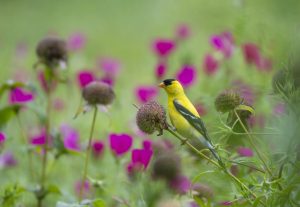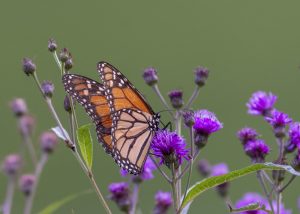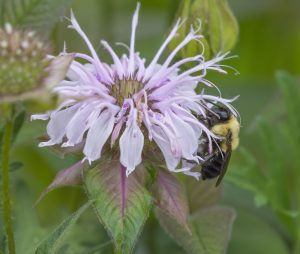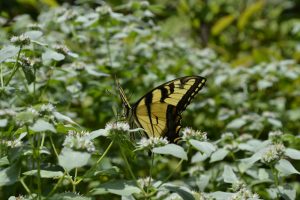Native Plants for Resilient Gardens
Photos courtesy of Liz Petit and Jenkins Arboretum & GardensThe best picks for changing weather conditions

For every home gardener, water could be your worst enemy or your best friend, depending on the day. Too much water can wreak havoc in the garden, yet there’s no garden without it!
With the increase in extreme weather events, summers are getting hotter, rainstorms are heavier and droughts linger longer, even in our area. Given these increasingly extreme conditions, you may wonder how to maximize your garden’s resiliency while minimizing your work there and your use of limited resources.
Thoughtfully selected native plants are the secret to creating a beautiful, tough, stress-free garden. This summer, spend time evaluating and exploring the options and then plan to establish your garden this fall to ensure a durable landscape to enjoy for many years with minimal effort, worry or drain on natural resources.
Evaluate

Before you hit your local garden center, spend time evaluating your garden. How does the sun hit this space throughout the day? Where does water pool and flow during rainstorms? Is your soil mostly clay, sand, silt, loam or some combination? Are there areas with added stresses of road salt, foot traffic or dog walkers?
While evaluating your landscape, make notes on light and soil conditions, space constraints and special considerations. You don’t need to be a climatologist or a soil scientist to gather useful information.
Getting to know your site while embracing your most curious self will set you up for success in building a resilient garden. In your quest to find “the right plant for the right place,” it’s important to know what conditions are at play before finding the right plant.
Explore

Now that you understand the environmental conditions of your garden, it’s time to research and ask the experts. Use your “field” notes to search online or in the library for plants that are both native to our region and will thrive within your garden’s unique set of growing conditions. There are many search tools online to help with this process.
When you identify a plant that might thrive in your garden, dig deeper (pun intended) and research its native habitat and range. In building a resilient garden in Pennsylvania, it’s helpful to look for native plants with our state as the northernmost reach of their natural range.
For example, if a plant is found growing naturally in wild areas from Florida up to Pennsylvania, you can feel confident it can survive in much warmer climates than what we typically experience in the mid-Atlantic. On the other hand, if Pennsylvania is the southernmost part of a plant’s natural range, the plant may suffer when we see increasingly high temperatures or drought in the future.

While doing your research, consider the pollinators and wildlife that interact with the plants you’re planning for your garden. Plants form the foundation of the food network and can make or break the health and survival of many other species. Knowing your site and researching it will help you navigate the options and make decisions maximizing the ecological value of your limited space, resulting in more impactful plant choices.
Ideally, spend time researching your selections this summer, then shop and plant in the fall. Armed with your well-researched wish list of plants (see below for suggestions), visit your local garden center or native plant nursery to shop. One option is Jenkins Arboretum & Gardens’ retail nursery, open every day, 9 a.m. to 4 p.m., and specializing in native plants. Plus, there are other native plant nurseries in the region as well as online.
Establish

Once you buy your plants, the next step is getting them in the ground. While many people think of spring as the best planting season, savvy gardeners know the ideal time to plant perennials, trees and shrubs is in the fall.
Without the pressure of hot summer days, plants established in fall can focus energy on sending out roots, rather than growing leaves or flowers. In southeastern Pennsylvania, fall typically welcomes increased rainfall, ensuring new plants get a good supply of moisture and saving you the labor of watering. When the following year comes, new plants will be much better equipped to handle the heat and dryness of summer.
Yet even the sturdiest plants need some investment on your part to help them get established. Commit to watering perennial plants diligently in the first season of growth, and trees and shrubs for the first three years. After the plants are established, they should be able to handle some extremes in weather without too much additional help. Remember to water deeply to encourage deep roots.
Help retain moisture by mulching, but remember that too much of a good thing can be very harmful to your plants. Unnecessarily thick layers of mulch can smother plants, cause rot and provide a cozy place for pests to hide, especially when heaped up against the base of a plant. Shredded leaves spread several inches deep in your garden is best, helping the soil retain moisture and adding critical organic material to your soil as the leaves break down.
Enjoy
After putting in the work of evaluating, exploring and establishing, it’s time to enjoy your resilient garden. Thoughtfully selected, well-established native plants will help your garden weather droughts, storms and other changes in climate.
Not only will you enjoy your garden, but the birds, insects and wildlife in your neighborhood will thrive in your landscape as well!
Resilient Native Plants
Some of our most resilient native plants are adaptable to a wide variety of conditions. It’s becoming typical in Pennsylvania to see long periods of drought followed by intense flooding and rainfall, making it important to select plants that can handle inconsistent conditions. While there are many plants to choose from, here are tried and true options that are widely available and easy to grow.

Adaptable perennials such as mountain mint (Pycnanthemum muticum), anise hyssop (Agastache foeniculum), and wild bergamot (Monarda fistulosa) are tough but beautiful. Each offers fragrant foliage and long-lasting blooms that attract pollinators.
For a resilient shrub or tree choice, look for red twig dogwood (Cornus sericea), St. John’s wort (Hypericum spp.) or serviceberry (Amelanchier laevis). Red twig dogwood can survive a wide variety of moisture conditions and won’t be phased by fall flooding. St. John’s wort is similarly able to withstand dry heat followed by heavy rainfall and sports cheery yellow flowers throughout the summer. Serviceberry is an underutilized, resilient tree with graceful white blooms in spring followed by deep red, edible berries in fall. This small deciduous tree can withstand tough and variable conditions, offering all season beauty with very little maintenance or pests.
Jenkins Arboretum & Gardens is a 48-acre public garden showcasing native flora of the eastern United States and a world-class collection of rhododendrons and azaleas. The gardens are open every day of the year, and admission is always free. Plan your visit by visiting Jenkins online at JenkinsArboretum.org.
Our Favorite Resources
- Arrowwood Landscape Design
- B&D Builders
- Ball & Ball
- Berk Hathaway Country Prop
- Berk Hathaway Holly Gross
- Berk Hathaway Missy Schwartz
- Cullen Construction
- Dayton Lock
- Dewson Construction
- E.C. Trethewey
- Homestead Structures
- Keystone Gun-Krete
- King Construction
- Main Street Cabinet Co.
- McComsey Builders
- Monument/Sotheby’s Int’l
- Mostardi Nursery
- Mountaintop Construction
- MR Roofing
- NV Homes
- Precise Buildings, LLC
- Rittenhouse Builders
- Sheller Energy
- Shreiner Tree Care
- Stable Hollow Construction
- Warren Claytor Architects
- Wedgewood Gardens
- White Horse Construction
